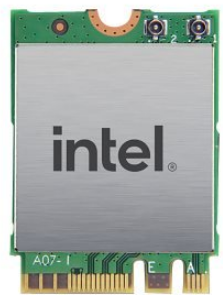Intel AX211 WiFi Adapter User Guide



Intel® WiFi Adapter Information
This version of Intel® PROSet/Wireless WiFi Software is compatible with the adapters listed below. Note that newer features provided in this software are generally not supported on older generations of wireless adapters.
The following adapters are supported in Windows* 10:
- Intel® Wi-Fi 6E AX211
- Intel® Wi-Fi 6E AX210
- Intel® Wi-Fi 6 AX203
- Intel® Wi-Fi 6 AX201
- Intel® Wi-Fi 6 AX200
- Intel® Wi-Fi 6 AX101 I
With your WiFi network card, you can access WiFi networks, share files or printers, or even share your Internet connection. All these features can be explored using a WiFi network in your home or office. This WiFi network solution is designed for both home and business use. Additional users and features can be added as your networking needs grow and change.This guide contains basic information about Intel adapters. Intel® wireless adapters enable fast connectivity without wires for desktop and notebook PCs. Depending on the model of your Intel WiFi adapter, your adapter is compatible with 802.11a, 802.11b, 802.11g, 802.11n, 802.11ac and 802.11ax wireless standards. Operating at 2.4GHz, 5GHz or 6GHz frequency, you can now connect your computer to existing high-speed networks that use multiple access points within large or small environments. Your WiFi adapter maintains automatic data rate control according to the access point location and signal strength to achieve the fastest possible connection.
Information in this document is subject to change without notice.
Intel Corporation assumes no responsibility for errors or omissions in this document. Nor does Intel make any commitment to update the information contained herein.
IMPORTANT NOTICE FOR ALL USERS OR DISTRIBUTORS:
Intel wireless LAN adapters are engineered, manufactured, tested, and quality checked to ensure that they meet all necessary local and governmental regulatory agency requirements for the regions that they are designated and/or marked to ship into. Because wireless LANs are generally unlicensed devices that share spectrum with radars, satellites, and other licensed and unlicensed devices, it is sometimes necessary to dynamically detect, avoid, and limit usage to avoid interference with these devices. In many instances Intel is required to provide test data to prove regional and local compliance to regional and governmental regulations before certification or approval to use the product is granted. Intel’s wireless LAN’s EEPROM, firmware, and software driver are designed to carefully control parameters that affect radio operation and to ensure electromagnetic compliance (EMC). These parameters include, without limitation, RF power, spectrum usage, channel scanning, and human exposure.
For these reasons Intel cannot permit any manipulation by third parties of the software provided in binary format with the wireless LAN adapters (e.g., the EEPROM and firmware). Furthermore, if you use any patches, utilities, or code with the Intel wireless LAN adapters that have been manipulated by an unauthorized party (i.e., patches, utilities, or code (including open source code modifications) which have not been validated by Intel), (i) you will be solely responsible for ensuring the regulatory compliance of the products, (ii) Intel will bear no liability, under any theory of liability for any issues associated with the modified products, including without limitation, claims under the warranty and/or issues arising from regulatory non-compliance, and (iii) Intel will not provide or be required to assist in providing support to any third parties for such modified products. Intel and the Intel logo are trademarks of Intel Corporation in the U.S. and/or other countries.Other names and brands may be claimed as the property of others. © Intel Corporation.
Regulatory Information
This section provides regulatory information for the following wireless adapters:
- Intel® Wi-Fi 6 AX200
- Intel® Wi-Fi 6 AX201
- Intel® Wi-Fi 6 AX203
- Intel® Wi-Fi 6E AX210 Intel® Wi-Fi 6E AX211
- Intel® Wi-Fi 6E AX101
NOTE: In this section, all references to the “wireless adapter” refer to all adapters listed above.The following information is provided
Information for the User
Regulatory Information
Regulatory ID
Information for OEMs and Host Integrators
NOTE: Due to the evolving state of regulations and standards in the wireless LAN field (IEEE 802.11 and similar standards), the information provided herein is subject to change. Intel Corporation assumes no responsibility for errors or omissions in this document.
INFORMATION FOR THE USER
Explosive Device Proximity Warning
- Warning: Do not operate a portable transmitter (including this wireless adapter) near unshielded blasting caps or in an explosive environment unless the transmitter has been modified to be qualified for such use
- Warning: The wireless adapter is not designed for use with high-gain directional antennas.
Use On Aircraft Caution
Caution: Regulations of commercial airline operators may prohibit airborne operation of certain electronic devices equipped with radio frequency devices (wireless adapters) because their signals could interfere with critical aircraft instruments.
Caution: This device is prohibited against use for the control of or communications with unmanned aircraft systems, including drones
Safety Approval Considerations
This device has been safety approved as a component and is for use only in complete equipment where the acceptability of the combination is determined by the appropriate safety agencies. When installed, consideration must be given to the following:
- The use of wireless adapters in hazardous locations is limited by the constraints posed by the safety directors of such environments.
- The use of wireless adapters on airplanes is governed by the Federal Aviation Administration (FAA).
- The use of wireless adapters in hospitals is restricted to the limits set forth by each hospital.
USA FCC Radio Frequency Exposure
The FCC with its action in ET Docket 96-8 has adopted a safety standard for human exposure to radio frequency (RF) electromagnetic energy emitted by FCC certified equipment. The wireless adapter meets the Human Exposure requirements found in FCC Part 2, 15C, 15E along with guidance from KDB 447498, KDB 248227 and KDB 616217. Proper operation of this radio according to the instructions found in this manual will result in exposure substantially below the FCC’s recommended limits.
The following safety precautions should be observed:
- Do not touch or move antenna while the unit is transmitting or receiving.
- Do not hold any component containing the radio such that the antenna is very close or touching any exposed parts of the body, especially the face or eyes, while transmitting.
- Do not operate the radio or attempt to transmit data unless the antenna is connected; this behavior may cause damage to the radio.
- Use in specific environments:
REGULATORY INFORMATION
USA – Federal Communications Commission (FCC)
This wireless adapter is restricted to indoor use due to its operation in the 5.15 to 5.25 and 5.470 to 5.75GHz frequency ranges. No configuration controls are provided for Intel® wireless adapters allowing any change in the frequency of operations outside the FCC grant of authorization for U.S. operation according to Part 15.407 of the FCC rules.
- Intel® wireless adapters are intended for installation by OEM integrators only.
- Intel® wireless adapters cannot be co-located with any other transmitter unless without further evaluation and acceptance by the FCC.
- Intel® wireless adapters must be used with the same type of antenna with equal or less maximum gains from the original approval.
- No trace antenna designs permitted without additional evaluation and FCC approval.
- Intel® wireless adapters are single modular approvals with no limited module conditions specified.
This wireless adapter complies with Part 15.247 and 15.407 of the FCC Rules. Operation of the device is subject to the following two conditions:
- This device may not cause harmful interference.
- This device must accept any interference that may cause undesired operation.
FCC Statment
Class B Device Interference Statement
This wireless adapter has been tested and found to comply with the limits for a Class B digital device, pursuant to Part 15 of the FCC Rules. These limits are designed to provide reasonable protection against harmful interference in a residential installation. This wireless adapter generates, uses, and can radiate radio frequency energy. If the wireless adapter is not installed and used in accordance with the instructions, the wireless adapter may cause harmful interference to radio communications. There is no guarantee, however, that such interference will not occur in a particular installation. If this wireless adapter does cause harmful interference to radio or television reception (which can be determined by turning the equipment off and on), the user is encouraged to try to correct the interference by taking one or more of the following measures:
- Reorient or relocate the receiving antenna of the equipment experiencing the interference.
- Increase the distance between the wireless adapter and the equipment experiencing the interference. -Connect the computer with the wireless adapter to an outlet on a circuit different from that to which the equipment experiencing the interference is connected.
- onsult the dealer or an experienced radio/TV technician for help.
NOTE: The adapter must be installed and used in strict accordance with the manufacturer’s instructions as described in the user documentation that comes with the product. Any other installation or use will violate FCC Part 15 regulations.
Modular Regulatory Certification Country Markings
Intel® Wi-Fi 6 AX200 (AX200NGW)
USA: Model AX200NGW, FCC ID: PD9AX200NG
Canada: Model AX200NGW, IC: 1000M-AX200NG
Intel® Wi-Fi 6 AX200 (AX200D2WL)
Due to the very small size of the AX200D2WL, the marking has been placed in this user manual because the product label on the device is considered too small to be readable.
USA: Model AX200D2WL, FCC ID: PD9AX200D2L
Canada: Model AX200D2WL, IC: 1000M-AX200D2L
Intel® Wi-Fi 6 AX201 (AX201NGW)
USA: Model AX201NGW FCC ID: PD9AX201NG
Canada: Model AX201NGW, IC: 1000M-AX201NG
Intel® Wi-Fi 6 AX201 (AX201D2W)
Due to the very small size of the AX201D2W, the marking has been placed in this user manual because the product label on the device is considered too small to be readable.
USA: Model AX210D2W FCC ID: PD9AX201D2
Canada: Model AX210D2W IC: 1000M-AX201D2
Intel® Wi-Fi 6 AX201 (AX201D2WL)
Due to the very small size of the AX201D2WL, the marking has been placed in this user manual because the product label on the device is considered too small to be readable.
USA: Model AX201D2WL, FCC ID: PD9AX201D2L
Canada: Model AX201D2WL, IC: 1000M-AX201D2L
Intel® Wi-Fi 6 AX203 (AX203NGW)
USA: Model AX203NGW, FCC ID: PD9AX203NG
Canada: Model AX203NG, IC: 1000M-AX203NG
Intel® Wi-Fi 6 AX203 (AX203D2W)
Due to the very small size of the AX203D2W, the marking has been placed in this user manual because the product label on the device is considered too small to be readable.
USA: Model AX203D2W, FCC ID: PD9AX203D2
Canada: Model AX203D2W, IC: 1000M-AX203D2
Intel® Wi-Fi 6 AX101 (AX101NGW)
USA: Model AX101NGW, FCC ID: PD9AX101NG
Canada: Model AX101G, IC: 1000M-AX101NG
Intel® Wi-Fi 6 AX101 (AX101D2W)
Due to the very small size of the AX1091D2W, the marking has been placed in this user manual because the product label on the device is considered too small to be readable.
USA: Model AX101D2W, FCC ID: PD9AX101D2
Canada: Model AX101D2W, IC: 1000M-AX101D2